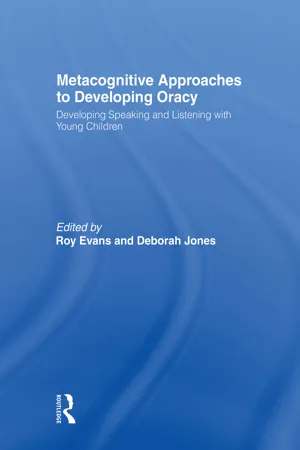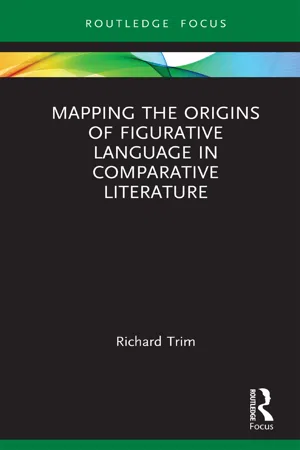Figurative Language
Figurative language refers to the use of words or expressions with a meaning that is different from the literal interpretation. It includes techniques such as similes, metaphors, personification, and hyperbole to create vivid imagery and convey abstract ideas. Figurative language is commonly used in literature, poetry, and everyday speech to add depth and creativity to communication.
6 Key excerpts on "Figurative Language"
- eBook - ePub
Metacognitive Approaches to Developing Oracy
Developing Speaking and Listening with Young Children
- Roy Evans, Deborah Jones(Authors)
- 2013(Publication Date)
- Routledge(Publisher)
...Hence, communicative patterns to which the child is exposed will become the mould of her subsequent individual development. We will here focus on one aspect of these tools, their figurativeness or metaphoric. Appropriating such tools is not just a cognitive act, it is also a communicative one, that is a social act, in the sense that it requires the child to be sensitive to what s/he needs to make clear in her/his speech in order to be understood by someone else (Pramling, 2006). Analysing Figurative Language use A metaphor states that something is what it cannot literally be (Cameron, 2003). For this reason, analysing metaphorical language means identifying and clarifying such cases of ‘discrepancy’ or ‘incongruence’ (Fichtner, 1999) between the terms in which something is referred to and what is being referred to. In addition, when analysing Figurative Language, what Goatly (1997) calls ‘metaphorical markers’ need to be attended to. Some examples of such markers would be: ‘as if’, ‘kind of’, ‘similar to’ and ‘as it were’. These kinds of terms signal that an utterance is not meant to be understood ‘literally’, but rather figuratively as a way of speaking. We will refer to these kinds of markers as ‘meta-communicative markers’ (Pramling, 2006); these markers should be attended to by the analyst, since they signal how an utterance is intended to be ‘taken’. How speakers intend their own utterances to be understood by others (and how these utterances are communicated as being understood by the speakers themselves) is visible, we argue, in the employment of the various kinds of ‘markers’ that speakers use in discourse to signal a non-literal use of language. Figurative features of language use in everyday conversation in preschool This presentation reports some preliminary observations and ideas about the uses of ‘non-literal’ modes of speaking in preschool...
- eBook - ePub
Linguistic Relativity Today
Language, Mind, Society, and the Foundations of Linguistic Anthropology
- Marcel Danesi(Author)
- 2021(Publication Date)
- Routledge(Publisher)
...6 Figurative Language Prologue In the late 1970s, the expanding interest of research on Figurative Language in linguistics led to a new paradigm in the field: cognitive linguistics. Today, this term has two main designations. It refers to: (1) (as in its initial designation), the study of figurative meaning, and especially metaphor, in language and discourse, and (2) any approach to the relation between language and cognition. In this chapter, the term is used in the first sense, since this is the relevant one for examining the LRH, and it is the one that is most compatible with current research paradigms in linguistic anthropology. It is somewhat surprising to find that Whorf did not see metaphor as consequential to the study of his own hypothesis. He claimed, for instance, that Hopi had fewer figurative devices than did SAE languages, in contrast to his main critic, Malotki (1983) who, instead, saw Hopi conceptualizations of time and space as based on such devices. Interestingly, Whorf does allude (perhaps unwittingly) to the importance of a feature of Figurative Language— synesthesia —or the identification of the properties of one sensory mode in terms of another (Whorf 1956: 155): Synesthesia, or suggestion by certain sense receptions of characters belonging to another sense, as of light and color by sounds and vice versa, should be made more conscious by a linguistic metaphorical system that refers to nonspatial experiences by terms for spatial ones, though undoubtedly it arises from a deeper source. Probably in the first instance metaphor arises from synesthesia and not the reverse; yet metaphor need not become firmly rooted in linguistic pattern, as Hopi shows. As George Lakoff (1987: 325), a key figure in the cognitive linguistic movement, pointed out, Whorf’s ideas sometimes appear to be inconsistent, especially as they refer to metaphor...
- eBook - ePub
- Maria Nikolajeva, Carole Scott(Authors)
- 2013(Publication Date)
- Routledge(Publisher)
...Figurative Language, Metafiction, and Intertext DOI: 10.4324/9780203960615-7 Visual symbolic language as such lies beyond the scope of our present study, if only because it has been investigated thoroughly by many scholars, mainly from the point of view of art criticism. There is a well-developed methodology for the discussion of this aspect. Visual symbols in picturebooks can be very complex and equivocal, contributing to the general complexity of texts, as many studies of, for instance, Maurice Sendak’s or Anthony Browne’s books clearly show. On the other hand, they can be quite lucid, hardly needing an especially keen eye. As far as verbal Figurative Language is concerned, that is, similes, personification, metaphors, and so on, some picturebooks abound in figures of speech, while others do not make use of them at all. Figurative Language is based on the shift in the literal meaning of a word and its transferred meaning. The usage of Figurative Language in the verbal text of picturebooks is not different from novels and does not therefore deserve any special attention. Instead, in this chapter we will explore some aspects of the text–image counterpoint on the level of language, including the phenomenon we have, for lack of a better term, called intraiconic texts, as well as metafiction and intertextuality. Signifier without Signified and Signified without Signifier: Figurative Language in Words and Images In picturebooks, images can enhance the verbal Figurative Language. For instance, the simile “fresh as a rose” or the idiom “green with envy” can be treated literally in a picture. Personification especially allows wide possibilities in picturebooks, where the sun and the moon, the four seasons, day and night, the wind, the rain, and so on are ascribed anthropomorphic features...
- Richard Trim(Author)
- 2021(Publication Date)
- Routledge(Publisher)
...In the search for the origins of Figurative Language, the words which can be read in a text therefore depend on the linguistic possibilities that a writer has available in the language of the literary work. Each language has its own morpho-syntactic, semantic and conceptual frameworks. This is revealed by the process of translation which demonstrates that it is not easy, and sometimes impossible, to transfer figurative innovation from one language to another. This also depends on the flexibility of poetic licence. From a mono- and multilingual perspective, linguistic structures therefore represent the first layer of the six-tier model in the order outlined in the previous chapter. Lawrence’s innovations, as well as those of other poets, are often difficult to re-convey in a foreign language using the same stylistic format. The conclusion from a contrastive linguistic approach is that the potential and the form of figurative invention in any language must depend partly on the lexical, semantic, phonological and morpho-syntactic structures available to the language concerned. The figurative expressions created by Lawrence in the examples given above combine feelings of love within an austere environment. What mental processes are involved in these textual and stylistic patterns? The second step requires investigating theories on human thought in relation to the words chosen...
- eBook - ePub
- Raia Prokhovnik(Author)
- 2019(Publication Date)
- Routledge(Publisher)
...Firstly, the term ‘metaphor’ covers a whole range of extensions from the literal meaning of words. Metaphor is not the opposite of literal language, but complements it. A literal meaning is that which is recognised, in the context in which it is being used, as primary, usual, unextended; and in thinking which is concerned with the ability of language to express multiple significances, it is the least interesting way in which words can be used; and a metaphorical meaning is simply an extended meaning. In some senses it would be easier to abandon the terms ‘literal’ and ‘metaphorical’, and talk instead of unextended and extended meanings and uses of words, or of meanings which cross barriers and those which don’t. But to change the vocabulary in this way would be likely to cause more confusion, in terms of general intelligibility, than it would avoid. Secondly, a metaphorical meaning is recognised and understood as a use of language within a particular context. A metaphor is not given a meaning – it has one within the context in which it is used and understood. And the significance, or multiple significances of a metaphor, correspond to the degree of complexity of the thinking expressed in language. The more complex the context of connections, associations and significances being drawn upon a piece of thinking, the more complex will be the meanings expressed in language. The meaning of a piece of thinking in language thus depends upon what is recognised as taking place in that particular context, in terms of the relationship between thinking and language, expressed in the use made of language...
- eBook - ePub
Introduction to Psycholinguistics
Understanding Language Science
- Matthew J. Traxler(Author)
- 2011(Publication Date)
- Wiley-Blackwell(Publisher)
...This chapter reviews different types of non-literal language, explains why non-literal expressions create challenges for any interpretation system, and describes different theories about how non-literal language is processed and interpreted. Types of Non-Literal Language Non-literal language comes in several different forms. There are indirect requests, like Can you open the door? Do you have the time? Would you pass the salt? (which contrast with direct requests or commands: Open the door! Tell me the time!) There are idioms like, Dave kicked the bucket, and Kathy spilled the beans. There are different kinds of metaphors, like, Susan flew down the street on her bicycle and That lecture was a sleeping pill. There is irony and sarcasm, such as when your friend says Now that was exciting, after the sleeping pill lecture. All of these forms have in common the characteristic that what the speaker said, the literal meaning, is different than the interpretation that the speaker wants you to formulate, the speaker meaning. Because what is said is different from the intended meaning, non-literal language requires the listener to draw pragmatic inferences, by combining information about the speaker, the context in which the expression is produced, and the literal content of the utterance to answer the questions: What meaning does the speaker wish to convey (what is on the speaker’s mind)? Why did the speaker produce that utterance in this context? How are these pragmatic inferences drawn so that the listener can see beyond the literal meaning to the speaker meaning? Answering this question entails solving two related problems. First, how do you know that the speaker does not intend a literal meaning? That is, how do you spot when the speaker is using non-literal, rather than literal, language? This is sometimes called the recognition problem (Stern, 2000)...





